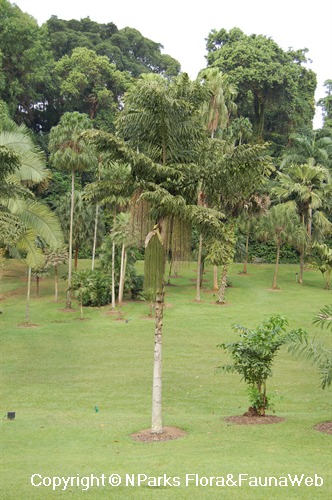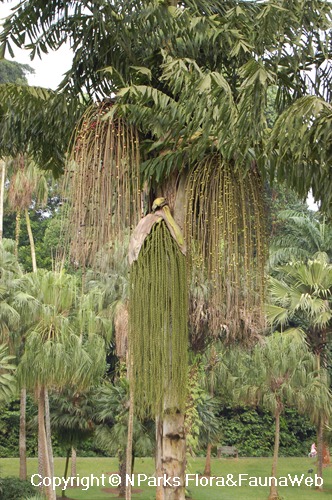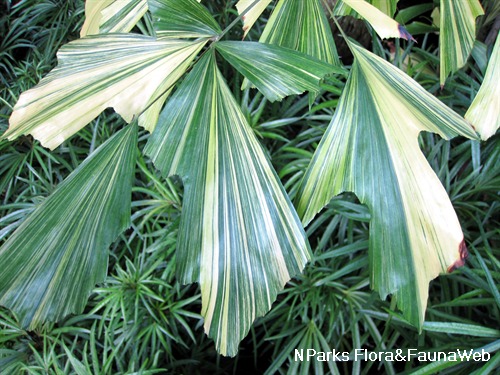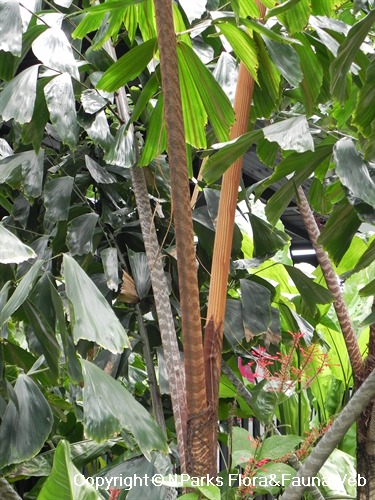
Back
Caryota rumphiana Mart.
| Family Name: | Arecaceae (Palmae) |
| Common Name: | Fishtail Palm, Solitary Fish Tail Palm |
Name
Classifications and Characteristics
| Plant Growth Form | Palm (Solitary Habit) |
|---|---|
| Maximum Height | 20 m |
| Maximum Plant Spread / Crown Width | 5 m |
Biogeography
| Native Distribution | Moluccas, New Guinea, Australia |
|---|
Description and Ethnobotany
| Trunk | Stem stout, light grey, ringed with prominent leaf scars, usually bulging in the middle; crownshaft absent. |
|---|---|
| Foliage | Fronds bipinnate, green, up to 6 m long; leaftlets usually triangular or deltoid in shape with jagged edges. |
| Others - Plant Morphology | Growth form: A solitary, spectacular palm with a stout, grey trunk that supports a dense, massive crown of large, stiffly spreading fronds with arching tips. Flower: Inflorescences massive, cream to yellow, 1.8 m long, emerging from amongst the fronds; flowers occur in groups of 3 (2 males and 1 female). Fruit: Fruits globular, reddish-pink whe ripe, 2 to 3.5 cm in diameter, single-seeded; seeds smooth, black, round with grooves. |
| Cultivation | Having versatile growth requirements, it is adeptly suitable to grow under full sun to shady location, thus also able to be grown indoors. Requires consistently moist, well-drained soils. Avoid over-watering. Tolerates mildy acidic to alkaline soils and prefers high humidity. Propagate by seeds. Seeds have low storage life thus they should be sown immediately. Seeds will take about 1 to 3 months to germinate and can be planted outdoors after a year. Caution: Fruit is a irritant and is inedible as the pulp conatins calcium oxalate crystals which can result to irritation to the skin and muscous membranes.Wear gloves when handling if need be. |
| Etymology | The genus epithet 'Caryota' comes from the Greek 'caryon', a nut. The species epithet 'rumphiana' is honoured after G.E. Rumpf (Rumphius), 17th and 18th century German botanist who collected in Indonesia. |
| Ethnobotanical Uses | Others: The trunk contains a starch which can be used to make sago. |
Landscaping Features
| Landscape Uses | Suitable for Roadsides |
|---|
Plant Care and Propagation
| Light Preference | Full Sun |
|---|---|
| Water Preference | Moderate Water |
| Plant Growth Rate | Moderate |
Foliar
| Mature Foliage Colour(s) | Green |
|---|---|
| Foliar Shape(s) | Palm Fronds (Bipinnate) |
| Leaf Area Index (LAI) for Green Plot Ratio | 2.5 (Palm - Solitary) |
Non - Foliar and Storage
| Trunk Type (Palm) | Solitary Habit, Aboveground |
|---|
Floral (Angiosperm)
| Flower Colour(s) | Cream / Off-White, Yellow / Golden |
|---|
Fruit, Seed and Spore
| Mature Fruit Colour(s) | Pink, Red |
|---|
Image Repository
Others
| Master ID | 1316 |
|---|---|
| Species ID | 2609 |
| Flora Disclaimer | The information in this website has been compiled from reliable sources, such as reference works on medicinal plants. It is not a substitute for medical advice or treatment and NParks does not purport to provide any medical advice. Readers should always consult his/her physician before using or consuming a plant for medicinal purposes. |





_lowres.jpg)